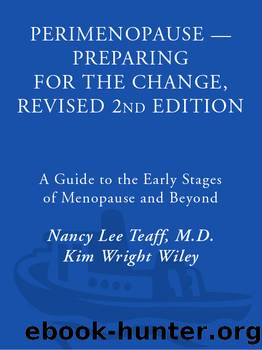Perimenopause--Preparing for the Change, Revised by Nancy Lee Teaff M.D

Author:Nancy Lee Teaff, M.D. [Teaff, Nancy Lee]
Language: eng
Format: epub
ISBN: 978-0-307-77466-8
Publisher: Harmony/Rodale
Published: 2011-01-05T00:00:00+00:00
Figure 6.1 X ray of normal and osteoporotic bones.
Another option is a bone density screening of the heel, which is cheaper than a DEXA (about $80, instead of the $200 to $300 often charged for a DEXA) and more readily available in some areas of the country. The machines are small and inexpensive enough that primary-care doctors can afford to have them in their offices; if the heel scan indicates a problem, the woman can then have a DEXA for a more complete diagnosis.
Figure 6.2 Skeletons of women with osteoporosis.
Adapted from Netter, F.D. The CIBA Collection of Medical Illustrations. Summit, NJ: CIBA-Geigy Corporation: 1987: 8 (pt1): 219.
Once an accurate measurement of your bone density has been obtained before menopause, a follow-up measurement can be done 12 to 18 months after your last period. If there has been a significant decrease in bone density, you are at a high personal risk for osteoporosis and should begin an aggressive preventive treatment regimen immediately. A low bone-density test for a woman in her 40s is a clear call to action.
Considering the ravages of osteoporosis, and how much it costs to treat it, you might wonder why these tests arenât done more frequently. As of July 1998, Medicare covers the cost of DEXA examsâbut of course the only women who benefit from this are women 65 or older. HMOs and health-insurance providers rarely cover the tests for younger women. Like most preventive medicine, bone scans are ultimately cost-effective. Early detection can help prevent many of the costly surgeries and physical therapy programs that individuals and the public health-care system currently pay forânot to mention the lifelong nursing-home care that half of all hip-fracture patients require.
Because women are most at risk for osteoporosis, and tests to screen for osteoporosis are rarely covered by insurance, this is another example of womenâs health-care concerns receiving more cavalier treatment than menâs. Also, the victims of osteoporosis are largely elderly and often silent when it comes to lobbying the health-care system. But if we baby boomers live en masse into our 80s as predicted, osteoporosis may play a major role in how well weâll maintain our independence. Itâs in our best interest to be vocal and educate ourselves about this disease before we experience it. For more information, call or write the National Osteoporosis Foundation (listed in the Sources section).
Download
This site does not store any files on its server. We only index and link to content provided by other sites. Please contact the content providers to delete copyright contents if any and email us, we'll remove relevant links or contents immediately.
| Breast Cancer | Candida |
| Chronic Fatigue Syndrome & Fibromyalgia | Endometriosis |
| General | Lupus |
| Menopause | Menstruation |
| Postpartum Depression | Pregnancy & Childbirth |
| Sexual Health |
Name Book, The: Over 10,000 Names--Their Meanings, Origins, and Spiritual Significance by Astoria Dorothy(2942)
Tone Your Tummy Type by Denise Austin(2789)
The Ultimate Guide to Anal Sex for Women by Tristan Taormino(2244)
The Coregasm Workout by Debby Herbenick(2221)
The Expectant Father by Armin A. Brott & Jennifer Ash(2219)
The Women's Health Fitness Fix by Jen Ator(2202)
Expecting Better by Emily Oster(2160)
She-ology by Sherry A. Ross MD(2133)
The Hite Report on Shere Hite by Shere Hite(2025)
Woman: An Intimate Geography by Natalie Angier(1884)
8 Steps to Reverse Your PCOS by Fiona McCulloch(1872)
Birth by Tina Cassidy(1866)
The Female Brain by M.D. Louann Brizendine(1858)
101 Get-Lean Workouts and Strategies by Muscle & Fitness(1808)
Women & the Weight Loss Tamasha by Diwekar Rujuta(1766)
50 Ways to Soothe Yourself Without Food by Susan Albers(1745)
The Big Booty Blueprint: Your Guide To A Bigger Butt In Less Than 12 Weeks by Bella Rahbek & Brandon Carter(1638)
Unleash the Power of the Female Brain: Supercharging Yours for Better Health, Energy, Mood, Focus, and Sex by Daniel G. Amen M.D(1532)
The overachievers by Robbins Alexandra(1528)
